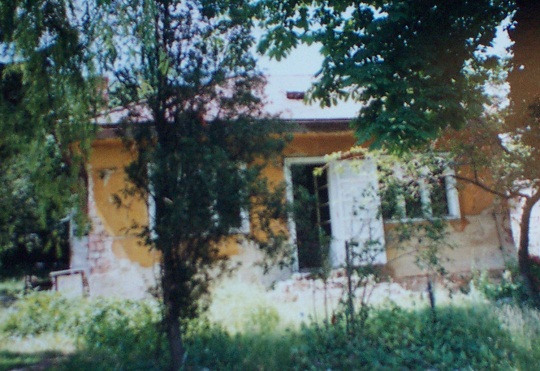 français français magyar magyar deutsch deutsch |
Talking with Angels
{ documents } |
 français français magyar magyar deutsch deutsch |
Talking with Angels
{ documents } |
|
from
Budaliget to Budapest Where did all 88 talks take place? Gitta’s
descriptions give a fair idea
of the three places where historical events took the four friends:
first the small house in Budaliget on the outskirts of Budapest, then
Hanna’s parents’ apartment on the east side of the city and finally
Katalin on the hills of Buda.
For those who do not know Budapest, this satellite view allows you to see where these places are. They are not far from one another: Katalin is 6 km away from the Lanchid bridge over the Danube, Budaliget 10 km away.
The first 40 talks
took place
in Budaliget over 9 months from 25 June 1943 to 24 March 1944 with the
exception of Dialogue N°24 on 3 December 1943, held in a friend’s
apartment while the Budaliget house was being whitewashed.
Gitta: “This led Joseph and Hanna to seek and ultimately find a small house not far from Budapest in the little village of Budaliget, for the purpose of starting a new and simple way of life. I soon joined them there and we worked just enough to support our daily needs. Lili joined us on the weekends.” (TA 2006, p.16) Gitta: “It was a tiny house with tiny windows for retirees from the railways. There wasn’t even a bathroom, just running water in the garden. We used to wash in a big tub. It was not at all comfortable. But we were happy because it was quiet.” (SB, Chap. III/2 )  The house in Budaliget where the first 40 dialogues took place. Lili stayed in Budapest to teach her classes in relaxation and personal development through free movement. At weekends, she took the bus or cycled to Budaliget to be with her friends. She slept in a converted tool shed. As for Gitta, she felt so committed to her relationship with Hanna and Joseph that she lived there full time. (SB, Chap. III/2 ) The small house was not far from the Mariaremete Church - Our Lady of the Hermits. “This long silence is suddenly broken by the incessant ringing of the bells of the nearby church, Mariaremete.” (TA 2006, p.260) According to Gitta, Hanna loved this church. She would stay there sometimes for three days over Christmas or Easter.
is located in
Einsiedeln, opposite
that same abbey. The statue of Our Lady of Ensiedeln the “Black Virgin”
is housed in a chapel in the abbey church and still attracts many
pilgrims. Daimon
Publishers has published Talking
with Angels in both English and German and other writings
about the book.
Pest Immediately after
the German invasion
of Hungary, Joseph and Hanna decided to return to Budapest where the
persecution of the Jewish people had not yet begun. They moved into
Hanna’s parents’ apartment at 4 Garay Street (GarayUtca 4)
in the city’s most modern area, east of the Danube river. Gitta went
with them. They stayed there for barely three months, from 31 March to
16 June 1944. Dialogues N°41 to N°58 took place there.
“Today
we await
the first dialogue in the apartment of Hanna’s parents, in the Garay
utca, which is situated in the Pest section of the city. Our ‘hosts’
have fortunately left Hungary a short time before to visit their son in
England, leaving the apartment empty. The front windows face a noisy,
gray street not far from the main east-side railway station, Keleti.
After the peace and calm of the tiny village of Budaliget, everything
here in Budapest seems abominably dismal and loud.” (TA
2006, p.293)
In an attempt to save Hanna and Lili, Gitta agreed to run a military clothing workshop set up to save Jewish women by a friend and by Father Klinda, a Catholic priest. The workshop was located in the Katalin Convent, at 46 Budakeszi Road (Budakeszi út 46). “A short time later, I find myself inspecting the Cloister Katalin in the villa quarter of Buda. It stands in the center of a large garden not far from the Jánoshegy Forest. Howevern the house itself, a former villa, is rather small and already bursting at the seams with women and children.” (DA 1990, p.290) Gitta set up a cabin in the garden. The last dialogues (N°59 to N°88) took place there from 21 June to 24 November 1944. While Gitta mentions
the “Katalin Convent”, Eva
Danos recounts how in 1944 the St. Catherine’s Home for Girls
became a war effort workshop:
“Within the Ranolder Institute, he founded the Klara Industrial High-school, where the output of the students was marketed by their own cooperative. Through his endeavors, the school became official supplier to the Central Military Outfitting Authority in 1938 - a position of advantage well used by him in 1944 to give shelter and to try and save those increasingly threatened with persecution. Katalin, the College of the Ranolder Institute, beacame a ‘war effort plant’, making military shirts and trousers as well as ‘bathing trunks’ using the off-cuts.” (PW, p. 13) Information contained within the file submitted for the recognition of Gitta as Righteous Among the Nations has allowed us to learn more about this building. It belonged to the Congregation of the Merciful Sisters. They had rented it to the Ranolder Institute, a teaching group led by Father Klinda, who used it as a Home for young girls. On 9 June 1944, Father Klinda was denounced for hiding 30 young Jewish women. He then turned the Home into a war effort workshop under the protection of the Apostolic Nunciature.
Today, the building houses the Lauder Javne Jewish School nursery section, the main premises of which were built on the adjoining land where the SS were based at the time. Sources:
|